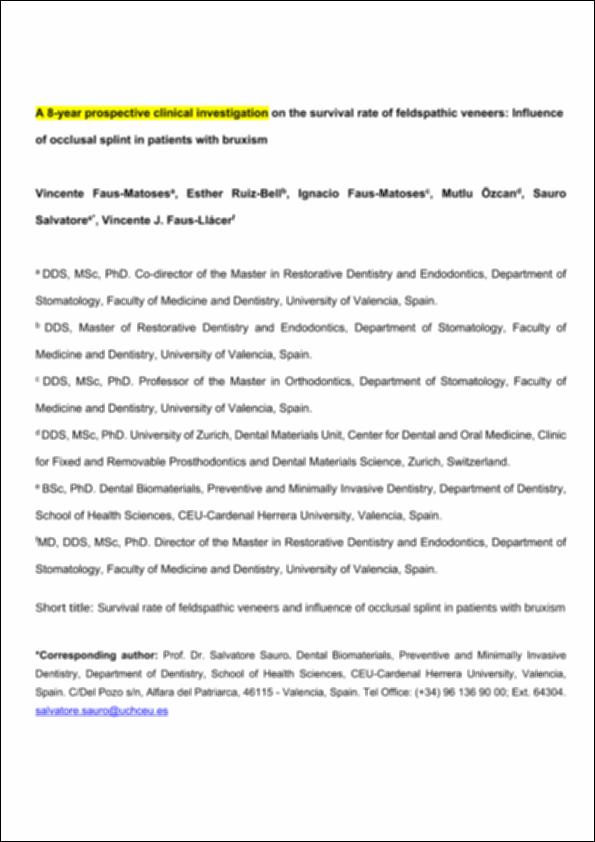Por favor, use este identificador para citar o enlazar este ítem:
http://hdl.handle.net/10637/13201An 8-year prospective clinical investigation on the survival rate of feldspathic veneers : influence of occlusal splint in patients with bruxism
| Título : | An 8-year prospective clinical investigation on the survival rate of feldspathic veneers : influence of occlusal splint in patients with bruxism |
| Autor : | Faus Matoses, Vicente Ruiz Bell, Esther Faus Matoses, Ignacio Özcan, Mutlu Sauro, Salvatore. Faus Llácer, Vicente |
| Materias: | Bruxismo - Tratamiento.; Bruxism - Treatment.; Splints, Bite plane.; Ortodoncia.; Carillas de porcelana.; Dental ceramics.; Férulas en odontología.; Orthodontics. |
| Editorial : | Elsevier. |
| Citación : | Faus-Matoses, V., Ruiz-Bell, E., Faus-Matoses, I., Özcan, M., Salvatore, S. & Faus-Llácer, V.J. (2020). An 8-year prospective clinical investigation on the survival rate of feldspathic veneers : influence of occlusal splint in patients with bruxism. Journal of Dentistry, vol. 99, art. 103352 (aug.). DOI: https://doi.org/10.1016/j.jdent.2020.103352 |
| Resumen : | Objectives: The aim of this study was to perform a 8-year prospective clinical investigation on the survival rate of feldspathic ceramic veneers, as well as analyse the influence of the occlusal splint in patients with parafunctional bruxism. Methods: Three hundred and sixty-four veneers fabricated using conventional feldspathic ceramic were provided in 64 patients. The patient sample included 40 individuals with bruxism. During the follow-up period, the effect of wearing the occlusal splint on the incidence of failure (fracture and/or debonding) in patients with bruxism was also assessed. The survival rate of veneers was determined using the Kaplan-Meier estimator. Statistical significance was set at p<0.05 with a confidence interval of 95%. Results: The occurrence of fracture for the feldspathic veneers tested in this study was 7.7%, while only 1.9% of the total number of veneers debonded. The overall survival rate was 93.7% after 3 years, 91% after 5 years, and 87.1% after 8 years. Patients with bruxism using an occlusal splint showed a survival rate of 89.1% after 7 years, while the survival rate in patients with bruxism using no occlusal splint was 63.9% (p<0.05). Conclusion: This study confirmed that feldspathic veneers may represent a suitable clinical approach for indirect aesthetic restorations. Such a treatment may be an option also for those patients affected by bruxism, as long as they regularly wear an occlusal splint. However, patients with bruxism using no occlusal splint may still present a potential higher risk of failure and/or debonding. |
| Descripción : | Este artículo se encuentra disponible en la siguiente URL: https://www.sciencedirect.com/science/article/abs/pii/S0300571220300944?via%3Dihub This is the pre-peer reviewed version of the following article: Faus-Matoses, V., Ruiz-Bell, E., Faus-Matoses, I., Özcan, M., Salvatore, S. & Faus-Llácer, VJ. An 8-year prospective clinical investigation on the survival rate of feldspathic veneers: influence of occlusal splint in patients with bruxism. Journal of Dentistry, vol. 99, art. 103352 (aug. 2020), which has been published in final form at https://doi.org/10.1016/j.jdent.2020.103352 Este es el pre-print del siguiente artículo: Faus-Matoses, V., Ruiz-Bell, E., Faus-Matoses, I., Özcan, M., Salvatore, S. & Faus-Llácer, VJ. An 8-year prospective clinical investigation on the survival rate of feldspathic veneers: influence of occlusal splint in patients with bruxism. Journal of Dentistry, vol. 99, art. 103352 (aug. 2020), que se ha publicado de forma definitiva en https://doi.org/10.1016/j.jdent.2020.103352 |
| URI : | http://hdl.handle.net/10637/13201 |
| Derechos: | http://creativecommons.org/licenses/by-nc-nd/4.0/deed.es |
| ISSN : | 0300-5712 |
| Fecha de publicación : | 25-ago-2020 |
| Centro : | Universidad Cardenal Herrera-CEU |
| Aparece en las colecciones: | Dpto. Odontología |
Los ítems de DSpace están protegidos por copyright, con todos los derechos reservados, a menos que se indique lo contrario.


